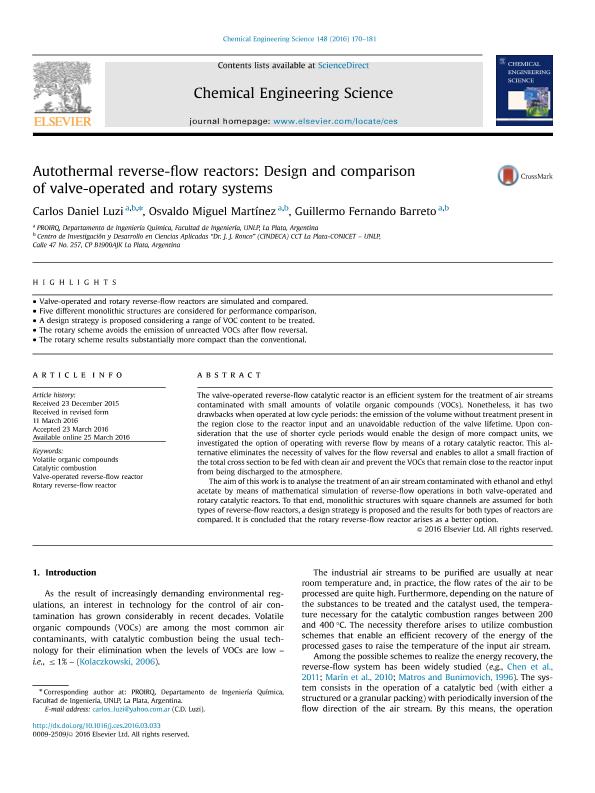Mostrar el registro sencillo del ítem
dc.contributor.author
Luzi, Carlos Daniel

dc.contributor.author
Martinez, Osvaldo Miguel

dc.contributor.author
Barreto, Guillermo Fernando

dc.date.available
2018-04-10T20:43:47Z
dc.date.issued
2016-03-25
dc.identifier.citation
Luzi, Carlos Daniel; Martinez, Osvaldo Miguel; Barreto, Guillermo Fernando; Autothermal reverse-flow reactors: design and comparison of vale-operated and rotary systems; Pergamon-Elsevier Science Ltd; Chemical Engineering Science; 148; 25-3-2016; 170-181
dc.identifier.issn
0009-2509
dc.identifier.uri
http://hdl.handle.net/11336/41634
dc.description.abstract
The valve-operated reverse-flow catalytic reactor is an efficient system for the treatment of air streams contaminated with small amounts of volatile organic compounds (VOCs). Nonetheless, it has two drawbacks when operated at low cycle periods: the emission of the volume without treatment present in the region close to the reactor input and an unavoidable reduction of the valve lifetime. Upon consideration that the use of shorter cycle periods would enable the design of more compact units, we investigated the option of operating with reverse flow by means of a rotary catalytic reactor. This alternative eliminates the necessity of valves for the flow reversal and enables to allot a small fraction of the total cross section to be fed with clean air and prevent the VOCs that remain close to the reactor input from being discharged to the atmosphere. The aim of this work is to analyse the treatment of an air stream contaminated with ethanol and ethyl acetate by means of mathematical simulation of reverse-flow operations in both valve-operated and rotary catalytic reactors. To that end, monolithic structures with square channels are assumed for both types of reverse-flow reactors, a design strategy is proposed and the results for both types of reactors are compared. It is concluded that the rotary reverse-flow reactor arises as a better option.
dc.format
application/pdf
dc.language.iso
eng
dc.publisher
Pergamon-Elsevier Science Ltd

dc.rights
info:eu-repo/semantics/openAccess
dc.rights.uri
https://creativecommons.org/licenses/by-nc-nd/2.5/ar/
dc.subject
Volatile Organic Compounds
dc.subject
Catalytic Combustion
dc.subject
Valve-Operated Reverse-Flow Reactor
dc.subject
Rotary Reverse-Flow Reactor
dc.subject.classification
Otras Ingeniería Química

dc.subject.classification
Ingeniería Química

dc.subject.classification
INGENIERÍAS Y TECNOLOGÍAS

dc.title
Autothermal reverse-flow reactors: design and comparison of vale-operated and rotary systems
dc.type
info:eu-repo/semantics/article
dc.type
info:ar-repo/semantics/artículo
dc.type
info:eu-repo/semantics/publishedVersion
dc.date.updated
2018-04-05T18:36:55Z
dc.journal.volume
148
dc.journal.pagination
170-181
dc.journal.pais
Países Bajos

dc.journal.ciudad
Amsterdam
dc.description.fil
Fil: Luzi, Carlos Daniel. Consejo Nacional de Investigaciones Científicas y Técnicas. Centro Científico Tecnológico Conicet - La Plata. Centro de Investigación y Desarrollo en Ciencias Aplicadas ; Argentina
dc.description.fil
Fil: Martinez, Osvaldo Miguel. Consejo Nacional de Investigaciones Científicas y Técnicas. Centro Científico Tecnológico Conicet - La Plata. Centro de Investigación y Desarrollo en Ciencias Aplicadas ; Argentina
dc.description.fil
Fil: Barreto, Guillermo Fernando. Consejo Nacional de Investigaciones Científicas y Técnicas. Centro Científico Tecnológico Conicet - La Plata. Centro de Investigación y Desarrollo en Ciencias Aplicadas ; Argentina
dc.journal.title
Chemical Engineering Science

dc.relation.alternativeid
info:eu-repo/semantics/altIdentifier/doi/http://dx.doi.org/10.1016/j.ces.2016.03.033
dc.relation.alternativeid
info:eu-repo/semantics/altIdentifier/url/https://www.sciencedirect.com/science/article/pii/S0009250916301385
Archivos asociados
